Properties and Characterization of New Approach Organic Nanoparticle-Based Biocomposite Board
Abstract
1. Introduction
2. Materials and Methods
2.1. Materials
2.2. Preparation of Coconut Shell Nanoparticles
2.3. Preparation of Composites
2.4. Characterization
2.4.1. Microstructure Properties
2.4.2. Mechanical Properties
2.4.3. Physical Properties
3. Results and Discussion
3.1. Microstructure Properties
3.2. Mechanical Properties
3.3. Physical Properties
4. Conclusions
Author Contributions
Funding
Acknowledgments
Conflicts of Interest
References
- Mu, B.; Wang, H.; Hao, X.; Wang, Q. Morphology, mechanical properties and dimensional stability of biomass particles/high density polyethylene composites: Effect of species and composition. Polymers 2018, 10, 308. [Google Scholar] [CrossRef] [PubMed]
- Zheng, D.; Zhang, Y.; Guo, Y.; Yue, J. Isolation and characterization of nanocellulose with a novel shape from walnut (Juglans Regia, L.) shell agricultural waste. Polymers 2019, 11, 1130. [Google Scholar] [CrossRef] [PubMed]
- Rizal, S.; Gopakumar, D.A.; Thalib, S.; Huzni, S.; Abdul Khalil, H. Interfacial compatibility evaluation on the fiber treatment in the Typha fiber reinforced epoxy composites and their effect on the chemical and mechanical properties. Polymers 2018, 10, 1316. [Google Scholar] [CrossRef] [PubMed]
- Mohanty, A.K.; Vivekanandhan, S.; Pin, J.-M.; Misra, M. Composites from renewable and sustainable resources: Challenges and innovations. Science 2018, 362, 536–542. [Google Scholar] [CrossRef] [PubMed]
- Faruk, O.; Bledzki, A.K.; Fink, H.-P.; Sain, M. Biocomposites reinforced with natural fibers: 2000–2010. Prog. Polym. Sci. 2012, 37, 1552–1596. [Google Scholar] [CrossRef]
- Nagalakshmaiah, M.; Afrin, S.; Malladi, R.P.; Elkoun, S.; Robert, M.; Ansari, M.A.; Svedberg, A.; Karim, Z. Biocomposites: Present trends and challenges for the future. In Green Composites for Automotive Applications; Elsevier: Amsterdam, The Netherlands, 2019; pp. 197–215. [Google Scholar]
- Eder, M.; Amini, S.; Fratzl, P. Biological composites—Complex structures for functional diversity. Science 2018, 362, 543–547. [Google Scholar] [CrossRef]
- Abdul Khalil, H.P.S.; Bhat, I.; Jawaid, M.; Zaidon, A.; Hermawan, D.; Hadi, Y. Bamboo fibre reinforced biocomposites: A review. Mater. Des. 2012, 42, 353–368. [Google Scholar] [CrossRef]
- Surya, I.; Olaiya, N.; Rizal, S.; Zein, I.; Sri Aprilia, N.; Hasan, M.; Yahya, E.B.; Sadasivuni, K.; Abdul Khalil, H. Plasticizer Enhancement on the Miscibility and Thermomechanical Properties of Polylactic Acid-Chitin-Starch Composites. Polymers 2020, 12, 115. [Google Scholar] [CrossRef]
- Business Wire. Available online: https://www.businesswire.com/news/home/20190919005726/en/World-Coconuts-Market-Analysis-Forecast-Size-Trends (accessed on 30 June 2020).
- Bledzki, A.K.; Mamun, A.A.; Volk, J. Barley husk and coconut shell reinforced polypropylene composites: The effect of fibre physical, chemical and surface properties. Compos. Sci. Technol. 2010, 70, 840–846. [Google Scholar] [CrossRef]
- Leman, A.S.; Shahidan, S.; Senin, M.S.; Hannan, N.I.R.R. A preliminary study on chemical and physical properties of coconut shell powder as a filler in concrete. IOP Conf. Ser. Mater. Sci. Eng. 2016, 160, 012059. [Google Scholar] [CrossRef]
- Chun, K.S.; Husseinsyah, S.; Osman, H. Mechanical and thermal properties of coconut shell powder filled polylactic acid biocomposites: Effects of the filler content and silane coupling agent. J. Polym. Res. 2012, 19, 9859. [Google Scholar] [CrossRef]
- Vasu, A.; Reddy, C.; Danaboyina, S.; Manchala, G.; Chavali, M. The Improvement in mechanical properties of coconut shell powder as filter in H.D.P.E. composites. J. Polym. Sci. Appl. 1 2017, 2, 2. [Google Scholar]
- Singh, A.; Singh, S.; Kumar, A. Study of mechanical properties and absorption behaviour of coconut shell powder-epoxy composites. Int. J. Mater. Sci. Appl. 2013, 2, 157–161. [Google Scholar] [CrossRef]
- Somashekhar, T.; Naik, P.; Nayak, V.; Rahul, S. Study of mechanical properties of coconut shell powder and tamarind shell powder reinforced with epoxy composites. MS&E 2018, 376, 012105. [Google Scholar]
- Durowaye, S.; Lawal, G.; Akande, M.; Durowaye, V. Mechanical properties of particulate coconut shell and palm fruit polyester composites. Int. J. Mater. Eng. 2014, 4, 141–147. [Google Scholar]
- Chary, M.; Sabeel, K. Experimental characterization of coconut shell particle reinforced epoxy composites. J. Mater. Environ. Sci. 2017, 8, 1661–1667. [Google Scholar]
- Müller, K.; Bugnicourt, E.; Latorre, M.; Jorda, M.; Echegoyen Sanz, Y.; Lagaron, J.M.; Miesbauer, O.; Bianchin, A.; Hankin, S.; Bölz, U. Review on the processing and properties of polymer nanocomposites and nanocoatings and their applications in the packaging, automotive and solar energy fields. Nanomaterials 2017, 7, 74. [Google Scholar] [CrossRef]
- Fu, S.; Sun, Z.; Huang, P.; Li, Y.; Hu, N. Some basic aspects of polymer nanocomposites: A critical review. Nano Mater. Sci. 2019, 1, 2–30. [Google Scholar] [CrossRef]
- Jalil, Z.; Rahwanto, A.; Ismail, I.; Sofyan, H.; Handoko, E. The use of nano-silicon carbide and nickel as catalyst in magnesium hydrides (MgH2) for hydrogen storage material application. Mater. Res. Express 2018, 5, 064002. [Google Scholar] [CrossRef]
- Hewitt, S.A.; Kibble, K.A. Effects of ball milling time on the synthesis and consolidation of nanostructured W.C.–Co composites. Int. J. Refract. Met. Hard Mater. 2009, 27, 937–948. [Google Scholar] [CrossRef]
- Delogu, F.; Gorrasi, G.; Sorrentino, A. Fabrication of polymer nanocomposites via ball milling: Present status and future perspectives. Prog. Mater. Sci. 2017, 86, 75–126. [Google Scholar] [CrossRef]
- Rizal, S.; Abdullah, C.; Olaiya, N.; Sri Aprilia, N.; Zein, I.; Surya, I.; Abdul Khalil, H.P.S. Preparation of Palm Oil Ash Nanoparticles: Taguchi Optimization Method by Particle Size Distribution and Morphological Studies. Appl. Sci. 2020, 10, 985. [Google Scholar] [CrossRef]
- Nuryawan, A.; Abdullah, C.; Hazwan, C.M.; Olaiya, N.; Yahya, E.B.; Risnasari, I.; Masruchin, N.; Baharudin, M.; Khalid, H.; Abdul Khalil, H.P.S. Enhancement of Oil Palm Waste Nanoparticles on the Properties and Characterization of Hybrid Plywood Biocomposites. Polymers 2020, 12, 1007. [Google Scholar] [CrossRef] [PubMed]
- Singh, P.; Abhash, A.; Yadav, B.; Shafeeq, M.; Singh, I.; Mondal, D. Effect of milling time on powder characteristics and mechanical performance of Ti4wt% Al alloy. Powder Technol. 2019, 342, 275–287. [Google Scholar] [CrossRef]
- Ismail, I.; Fathmiyah, S.; Jalil, Z.; Abdul Khalil, H.P.S. Effect of ball-milling time on chemical property of coconut shell powder. J. Phys. Conf. Ser. 2020, 1572, 012021. [Google Scholar] [CrossRef]
- Owodunni, A.A.; Lamaming, J.; Hashim, R.; Taiwo, O.F.A.; Hussin, M.H.; Kassim, M.H.M.; Bustami, Y.; Sulaiman, O.; Amini, M.H.M.; Hiziroglu, S. Properties of green particleboard manufactured from coconut fiber using a potato starch based adhesive. BioResources 2020, 15, 2279–2292. [Google Scholar]
- Bellow, S.; Agunsoye, J.; Adebisi, J.; Kolawole, F.; Hassan, S. Physical properties of coconut shell nanoparticles. Kathmandu Univ. J. Sci. Eng. Technol. 2016, 12, 63–79. [Google Scholar] [CrossRef]
- Iqbaldin, M.M.; Khudzir, I.; Azlan, M.M.; Zaidi, A.; Surani, B.; Zubri, Z. Properties of coconut shell activated carbon. J. Trop. For. Sci. 2013, 25, 497–503. [Google Scholar]
- Krishna, S.; Patel, C.M. Preparation of coconut shell nanoparticles by wet-stirred media milling. Mater. Lett. 2019, 257, 126738. [Google Scholar] [CrossRef]
- Zheng, Y.; Fu, Z.; Li, D.; Wu, M. Effects of ball milling processes on the microstructure and rheological properties of microcrystalline cellulose as a sustainable polymer additive. Materials 2018, 11, 1057. [Google Scholar] [CrossRef]
- Mattonai, M.; Pawcenis, D.; del Seppia, S.; Łojewska, J.; Ribechini, E. Effect of ball-milling on crystallinity index, degree of polymerization and thermal stability of cellulose. Bioresour. Technol. 2018, 270, 270–277. [Google Scholar] [CrossRef] [PubMed]
- Kocaefe, D.; Poncsak, S.; Boluk, Y. Effect of thermal treatment on the chemical composition and mechanical properties of birch and aspen. BioResources 2008, 3, 517–537. [Google Scholar]
- Yunos, N.F.M.; Zaharia, M.; Ahmad, K.R.; Nath, D.; Iwase, M.; Sahajwalla, V. Structural transformation of agricultural waste/coke blends and their implications during high temperature processes. ISIJ Int. 2011, 51, 1185–1193. [Google Scholar] [CrossRef]
- Bello, S.A.; Agunsoye, J.O.; Hassan, S.B. Synthesis of coconut shell nanoparticles via a top down approach: Assessment of milling duration on the particle sizes and morphologies of coconut shell nanoparticles. Mater. Lett. 2015, 159, 514–519. [Google Scholar] [CrossRef]
- Ismail, I.; Aini, Q.; Jalil, Z.; Fadzullah, S.H.S.M. Mechanical and physical properties of the rice straw particleboard with various compositions of the epoxy resin matrix. J. Phys. Conf. Ser. 2018, 1120, 012014. [Google Scholar] [CrossRef]
- Institute, A.N.S. Particleboard. ANSI A208. 1; Composite Panel Association: Leesburg, Virginia, 2009. [Google Scholar]
- Bhaskar, J.; Singh, V. Physical and mechanical properties of coconut shell particle reinforced-epoxy composite. J. Mater. Environ. Sci. 2013, 4, 227–232. [Google Scholar]
- Jena, H.; Pradhan, A.K.; Pandit, M.K. Studies on water absorption behaviour of bamboo–epoxy composite filled with cenosphere. J. Reinf. Plast. Compos. 2014, 33, 1059–1068. [Google Scholar] [CrossRef]
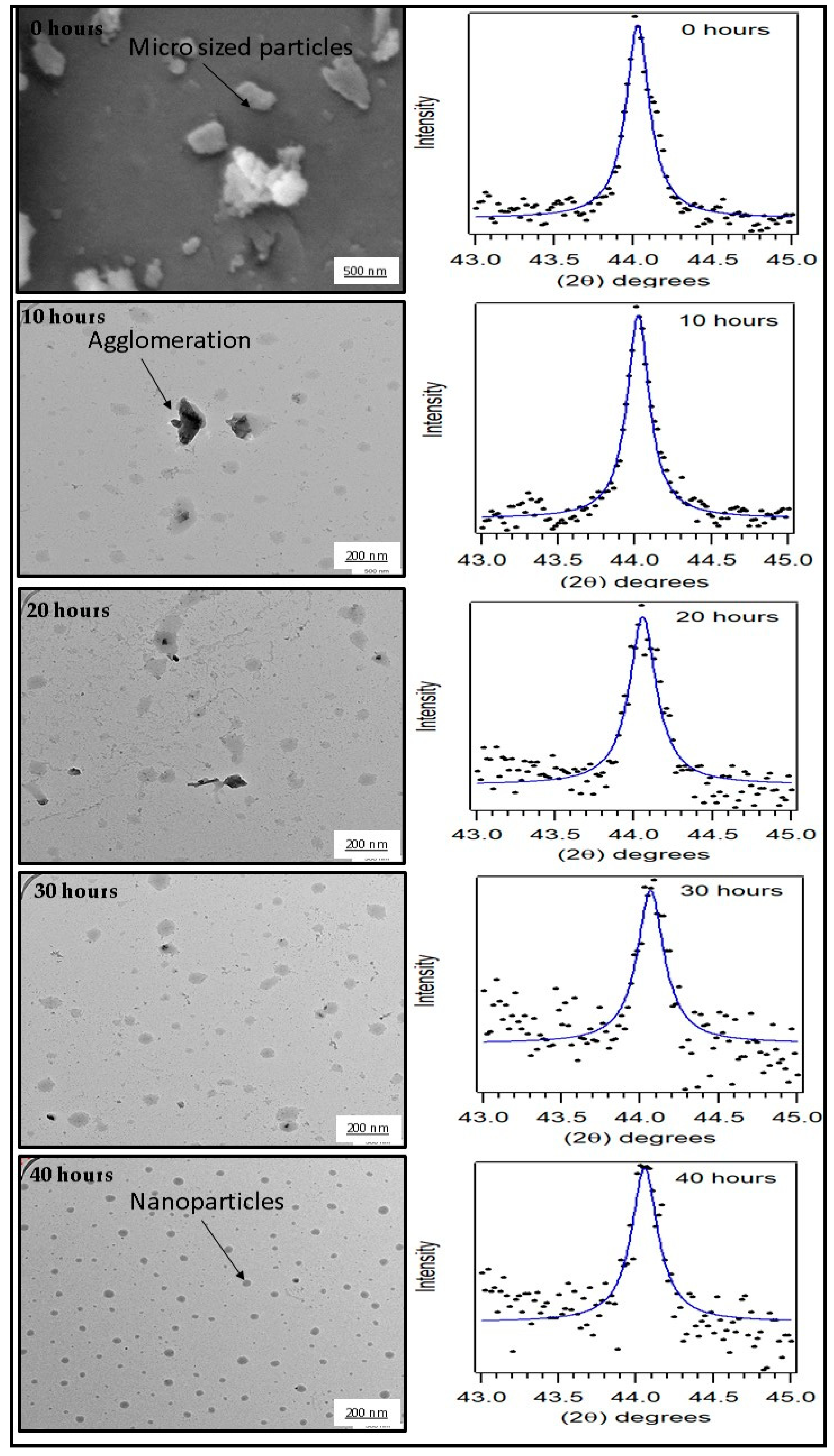
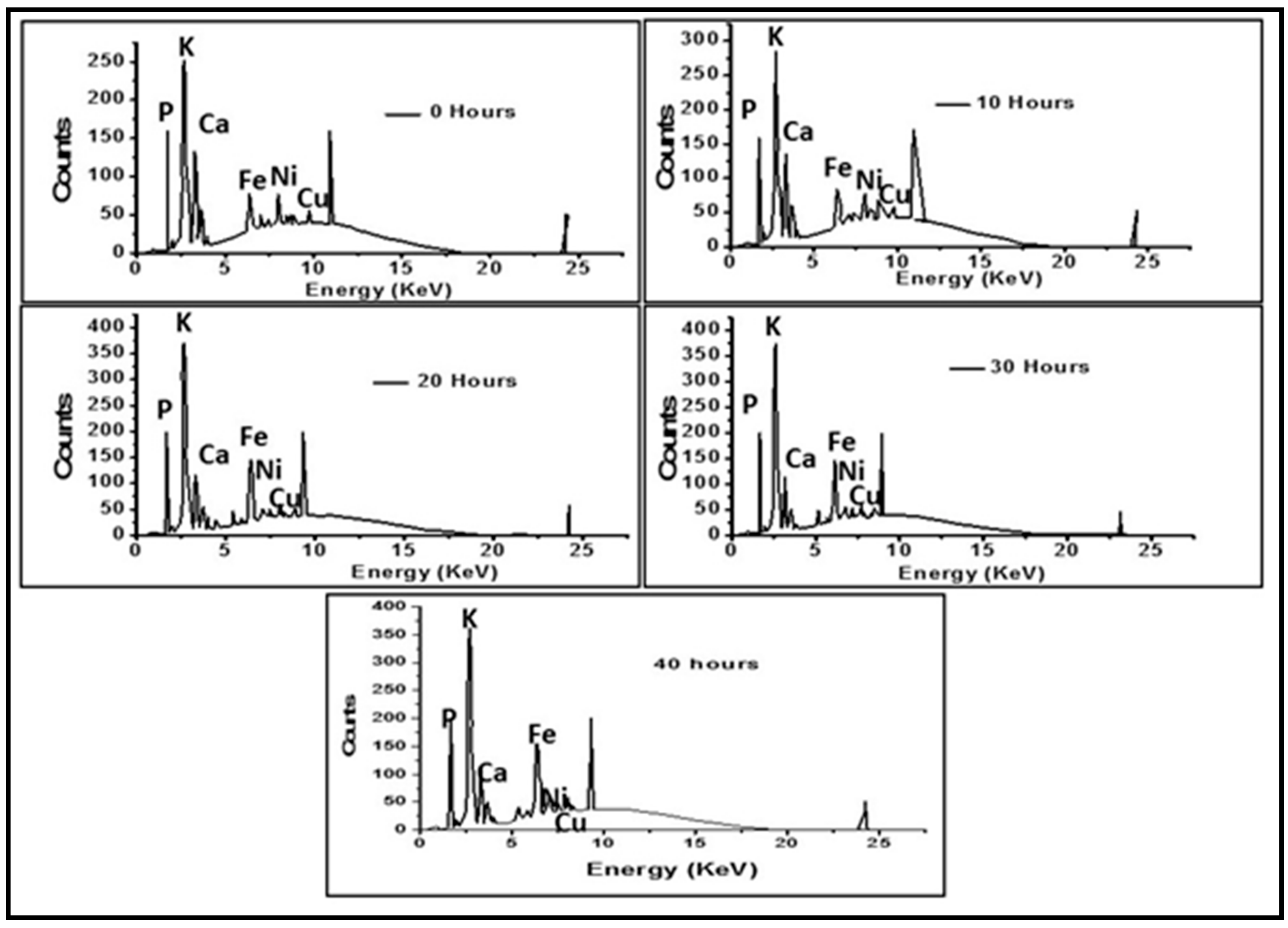

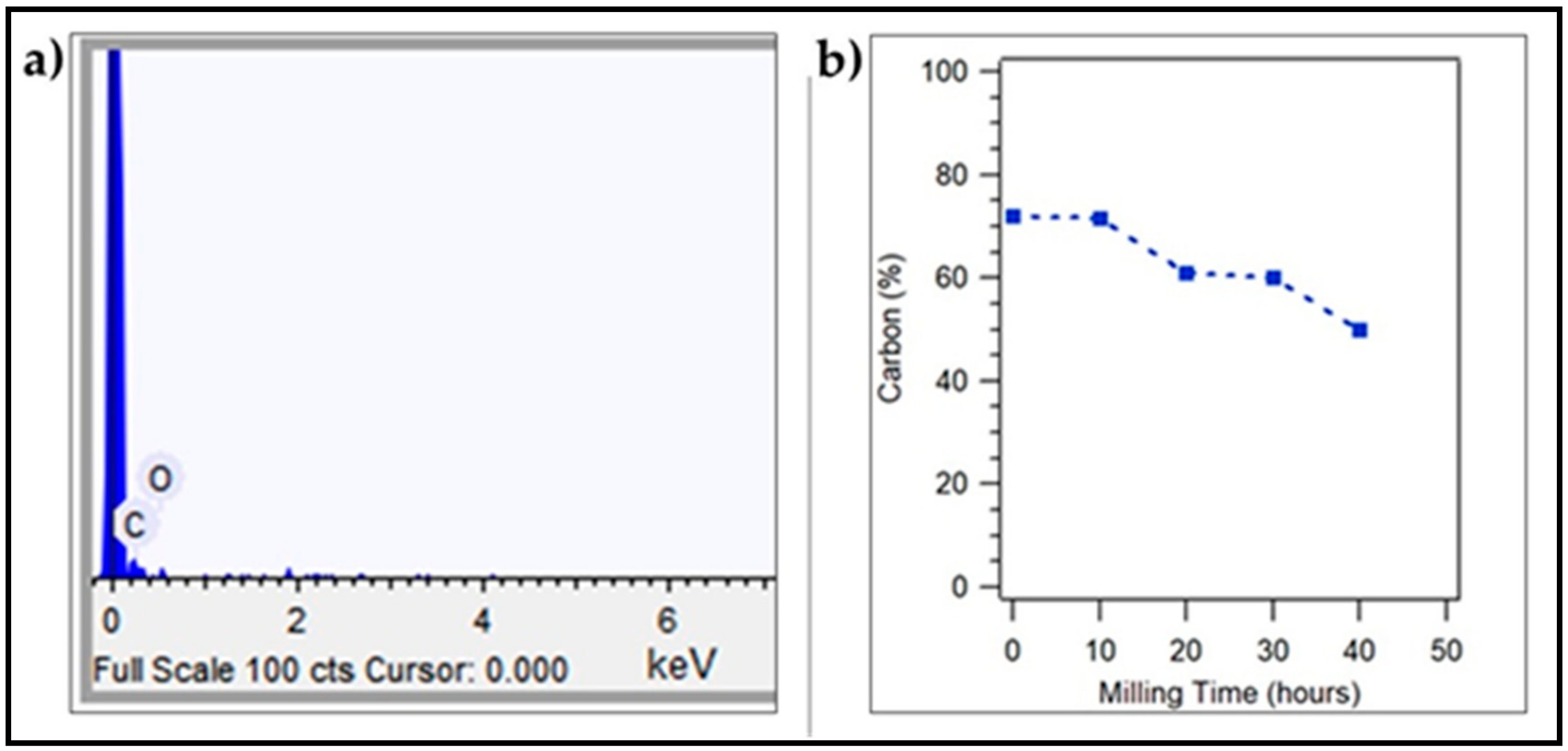

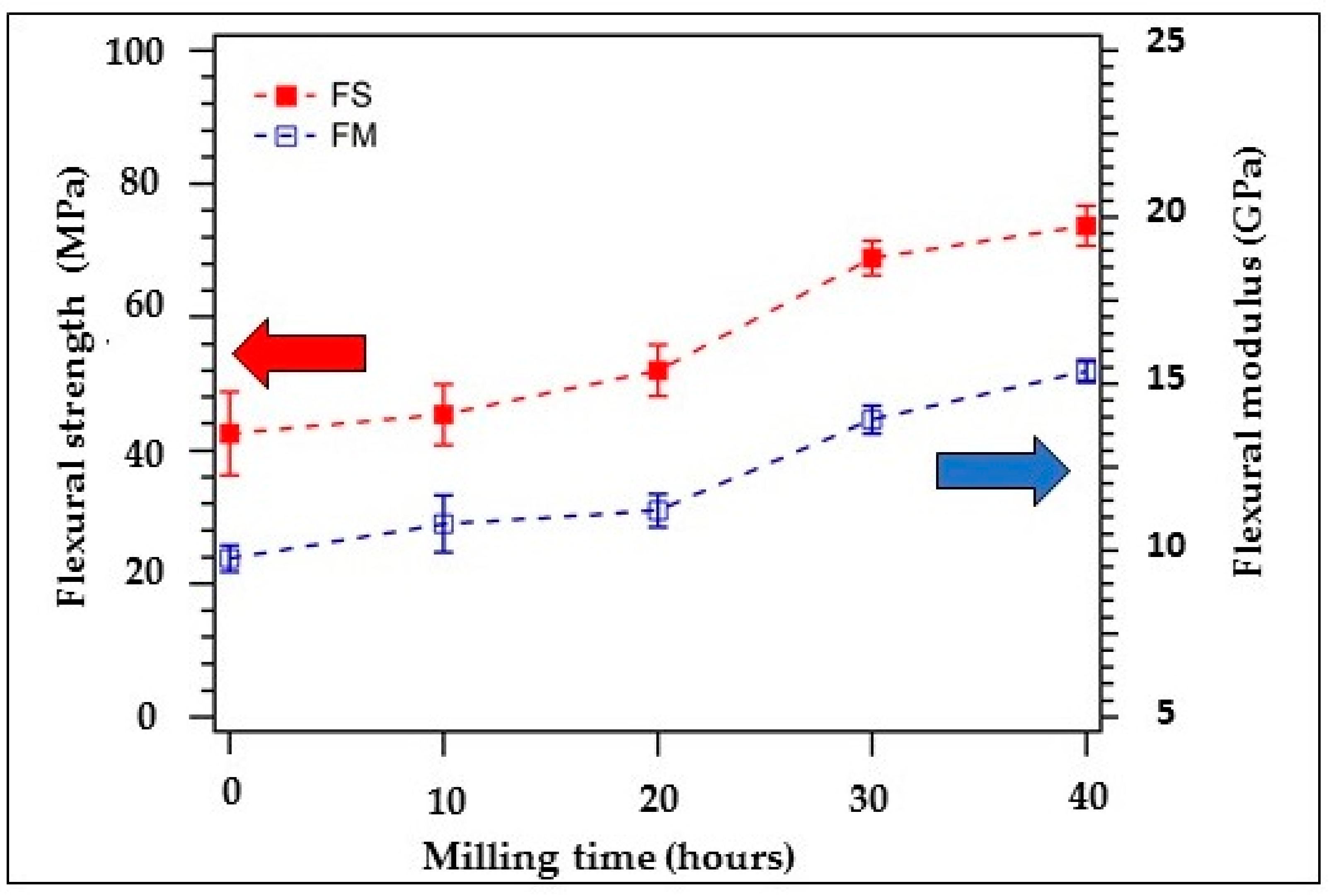

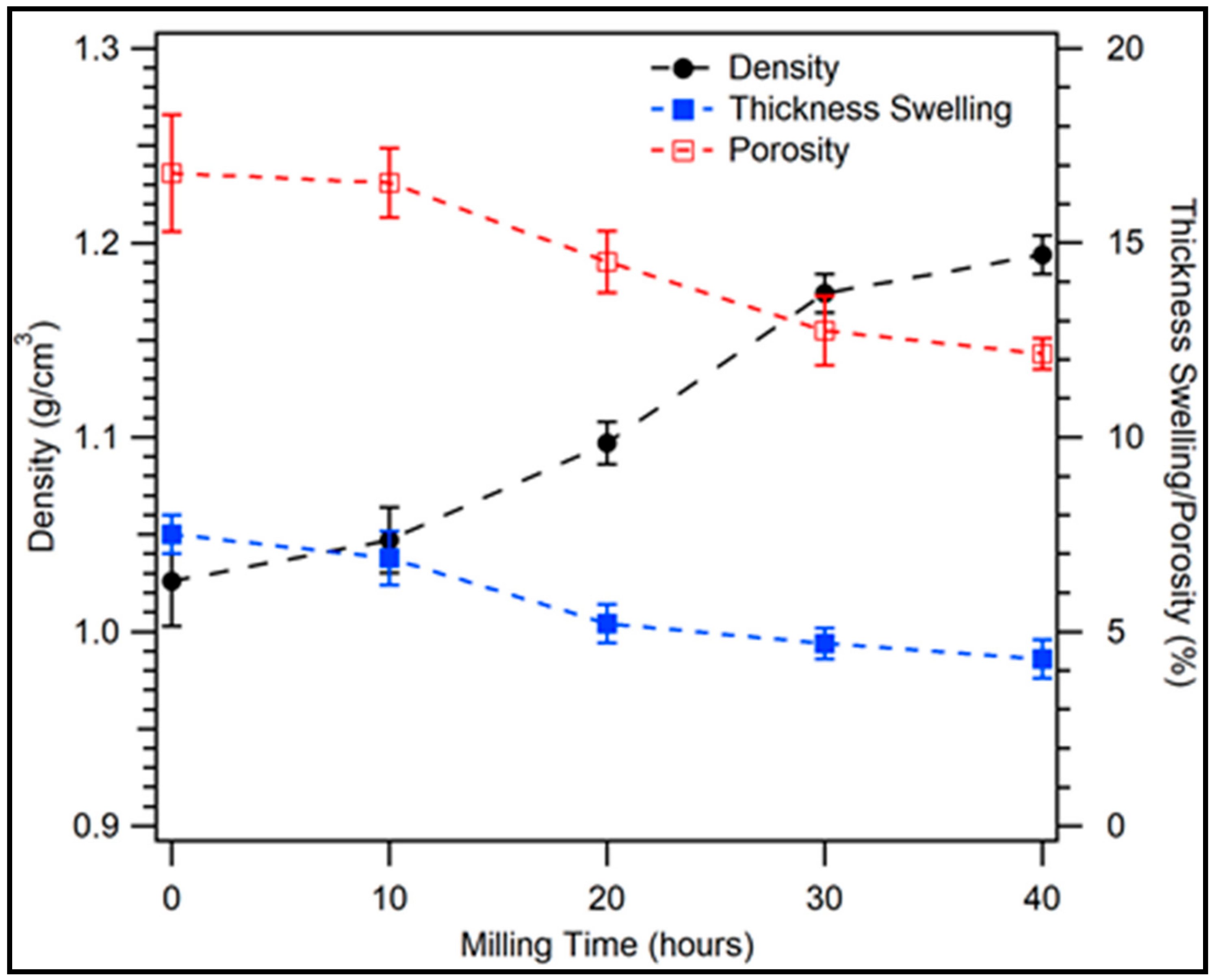
| Miling Time | K (wt.%) | Ca (wt.%) | Fe (wt.%) | P (wt.%) | Cu (wt.%) | Ni (wt.%) |
|---|---|---|---|---|---|---|
| 0 h | 48.6 | 25.4 | 12.2 | 5.3 | 3.1 | 0.8 |
| 10 h | 42.1 | 21.1 | 28.5 | 4.1 | 3.3 | 1.2 |
| 20 h | 38.8 | 19.2 | 28.6 | 4.4 | 3.7 | 2.1 |
| 30 h | 38.7 | 18.5 | 30.0 | 3.9 | 3.6 | 2.0 |
| 40 h | 38.0 | 17.4 | 32.2 | 4.2 | 3.6 | 1.9 |
| Milling Times | SEM | AFM |
|---|---|---|
| 0 h |  |  |
| 10 h |  |  |
| 20 h |  |  |
| 30 h |  |  |
| 40 h |  |  |
© 2020 by the authors. Licensee MDPI, Basel, Switzerland. This article is an open access article distributed under the terms and conditions of the Creative Commons Attribution (CC BY) license (http://creativecommons.org/licenses/by/4.0/).
Share and Cite
Ismail, I.; Arliyani; Jalil, Z.; Mursal; Olaiya, N.G.; Abdullah, C.K.; Fazita, M.R.N.; Abdul Khalil, H.P.S. Properties and Characterization of New Approach Organic Nanoparticle-Based Biocomposite Board. Polymers 2020, 12, 2236. https://doi.org/10.3390/polym12102236
Ismail I, Arliyani, Jalil Z, Mursal, Olaiya NG, Abdullah CK, Fazita MRN, Abdul Khalil HPS. Properties and Characterization of New Approach Organic Nanoparticle-Based Biocomposite Board. Polymers. 2020; 12(10):2236. https://doi.org/10.3390/polym12102236
Chicago/Turabian StyleIsmail, I., Arliyani, Z. Jalil, Mursal, N. G. Olaiya, C. K. Abdullah, M. R. N. Fazita, and H. P. S. Abdul Khalil. 2020. "Properties and Characterization of New Approach Organic Nanoparticle-Based Biocomposite Board" Polymers 12, no. 10: 2236. https://doi.org/10.3390/polym12102236
APA StyleIsmail, I., Arliyani, Jalil, Z., Mursal, Olaiya, N. G., Abdullah, C. K., Fazita, M. R. N., & Abdul Khalil, H. P. S. (2020). Properties and Characterization of New Approach Organic Nanoparticle-Based Biocomposite Board. Polymers, 12(10), 2236. https://doi.org/10.3390/polym12102236








